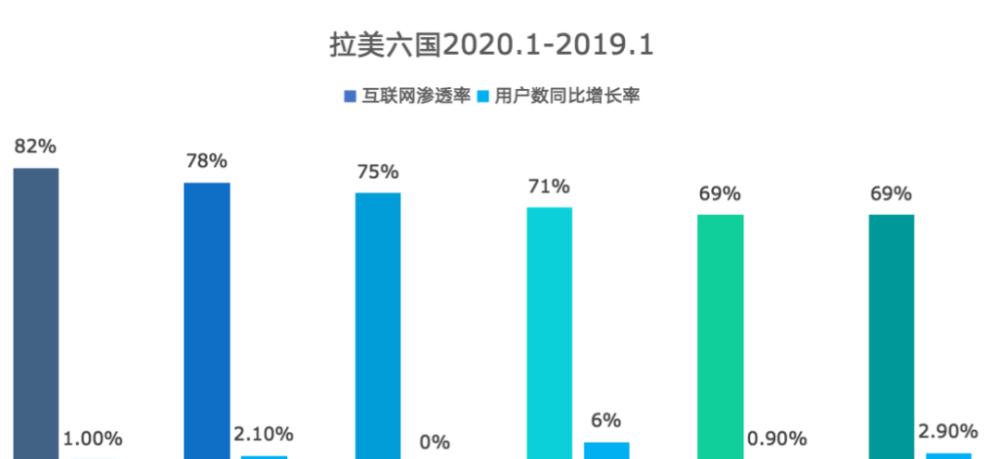Latin America and Southeast Asia, which are also emerging markets, have many similarities, such as having a young demographic structure and a huge demographic dividend. However, Latin American culture is more inclined to Europe and the United States, which makes some marketing strategies that have worked well in Southeast Asia appear unsatisfactory in Latin America.
On the other hand, most mobile application manufacturers have launched multilingual versions in Latin America in the spirit of global distribution, but they have not been close to the local market and have done in-depth operations.
How to deepen the localization marketing in Latin America? The world-renowned shooting mobile game "Free Fire" has delivered a wonderful answer sheet in Latin America.
01
Characteristics of the Latin American market
Affected by multiple internal and external factors, the Latin American economy has experienced low-speed growth for 6 consecutive years. In recent years, the per capita GDP and per capita consumption in Latin America have declined. Brazil, Mexico and Argentina are the three countries with the highest GDP in the region and are also the best choice for going to sea.
Internet penetration in Latin America is relatively low, but in recent years various countries have increased to varying degrees. At the same time, the smartphone ownership rate in Brazil, Mexico, Colombia and Argentina has approached or exceeded 90%.

Source: Hootsuite
Compared with China, Japan and South Korea, Europe and the United States and other regions, the network bandwidth in Latin America is not high, and most of the mobile phones are entry-level, with an average price of about 1500RMB, and the memory space is not large.
In terms of player preferences, although the geographical location is close to North America, unlike the U.S. market dominated by casual games, Brazilian players prefer competitive, sports and racing mobile games. A quarter of Brazilian gamers say they enjoy the thrill of beating others and choose to play the game. In addition, character upgrades and sci-fi themes will be more popular with Brazilian players.
Source: Newzoo
Latin American people love to compete and compete with each other, in addition to offline events, they basically have online events every week, if they can get a certain degree of attention at the event level, it will bring good returns to the reputation of the game and the stickiness of players to the game. The main platforms for Latin American game users to watch live streams include NimoTV, BOOYAH, YouTube and Twitch (Spanish for Latin America), and TikTok has gradually become the preferred live streaming platform in Latin America.
02
Free Fire's Latin American approach to localization marketing
In the shooting competitive mobile game track surrounded by star products such as "Fortnite", "PUBG MOBILE", "Wilderness Survival" and so on, "Free Fire" has achieved great success in Latin America with a differentiated strategy of low-end configuration. Compared to PUBG MOBILE, which requires 1.9G, Free Fire requires only 600MB of RAM.
At the same time, the natural competitiveness of "Free Fire" directly cuts to the cool point of Brazilian players. In the game, you can see the importance of the Brazilian market everywhere, such as the skin of the Brazilian Carnival, the Brazilian city brasilia, and the character Alk set by the famous Brazilian DJ.
Free Fire's fast-paced, short 10-minute game and open-ended gameplay, as well as a high degree of freedom, can be said to have been built for eSports. In addition to online BOOYAH, YouTube and other live streaming platforms, Free Fire Esports will also appear on Brazilian cable TV and pay TV to broadcast the game for a national audience. The winner will compete for the 2022 Free Fire World League in Sentosa, Singapore, competing for a prize pool of over $140,000.
The e-sports event has led a large number of KOLs and fans to spontaneously produce UGC on different platforms, making "Free Fire" truly a national mobile game. KOL Nobru is a Free Fire pro player & biggest streamer who won the Free Fire esports competition in Brazil and has 13.3 million followers on his YouTube account. ▼
Latin Americans love football, football culture prevails, and Latin Americans are good at hot dancing. Free Fire has been a sponsor of the Brazilian Football Confederation for two consecutive years, and has introduced skins and items exclusive to the Brazilian national team for Brazilian players in the game.
Many players of "Free Fire" are also electronic music lovers, in February this year, based on a deep understanding of players, the game launched an exclusive electronic music campaign Channel BEAT, and cooperated with several DJs to release a series of music, customizing exclusive songs for the 4 characters inside, players can not only receive a set of skin sets, but also enjoy the revised interface, special collections and unique rewards. ▼
Source: AppGrowing International Edition
Known as the world's largest carnival, the Brazilian Carnival takes place for three days in mid or late February each year, and is temporarily postponed to April in 2022 due to the epidemic.
Although the 2022 offline carnival has been postponed, but it has not affected the online in the slightest, FreeFire has launched a new role for the 2022 Brazilian Carnival, Otho. During the Carnival, players will be able to complete dozens of adventure missions and receive rewards in a variety of themes, including exclusive characters, props, and challenge missions. ▼
In summary, "Free Fire" has made it a national mobile game in Latin America through product inclusion, celebrity promotion, e-sports events, and content updates. This is inseparable from a deep understanding of users and a deep localization strategy.